1 . The life of a journalist can be exciting. To be in constant pursuit of the latest news demands a curiosity that can only be rewarded by getting to “where it is happening” as soon as possible. The goal, of course, is to relate what is happening to the public as clearly as possible.
However, every journalist must be careful to report not only a vivid picture of what is happening, but a true picture. Each journalist reports his or her own version of what has taken place. Still, this version must be an actual account if the reporter is to maintain a reliable reputation.
In order to get to the truth in some new stories, a reporter must rely on the statements of someone who is on the inside of the situation. Often this insider will only talk to a reporter if the reporter promises never to reveal the insider’s name. The insider usually threatens never to admit meeting with the reporter if his or her name is revealed.
Because stories of this nature often involve criminal activity, reporting them becomes a dangerous job. This kind of work involved in obtaining news in this summer serves as an inviting situation for the underworld as well as the legal world. Members of the underworld want to find out who the insider is so that they can keep him or her quiet. Members of the legal world claim that the reporter will disturb justice if he or she fails to disclose the insider’s name.
Rather than be unaccountable to a trusted informant, most reporters will go to jail if need be. Freedom of the press is provided by the First Amendment of the Constitution of the United States. Impure interpretations of this portion of the constitution cause a small number of reporters to be jailed every year. However, as yet, no amount of legal maneuvering (操纵) has been able to put out this light of freedom set up by our forefathers. All of the reporters refusing to reveal the names of their informants have eventually been released.
Devotion of this kind has given journalism its reputation for reliability — a reliability that each journalist is expected to uphold in his or her search for truth. Supplying a truthful account of each day’s occurrence is the serious contract made between reporter and the public.
1. According to the passage, those who give inside information ________.| A.are usually under police protection |
| B.do not want their names made public |
| C.are on rare occasions on good terms with reliable reporter |
| D.often have difficulty in protecting their lives |
| A.scheming | B.unknowing | C.stirring | D.tempting |
| A.the courts sometimes misinterpret the First Amendment of the Constitution |
| B.they get inside stories by dishonest means |
| C.they are against the First Amendment of the Constitution |
| D.there is no law in the United States to protect freedom of the press |
| A.seldom follows the First Amendment of the Constitution of the United States |
| B.should be diligent, clever and inventive |
| C.must provide the public with a truthful account as clearly as possible |
| D.must try every means to satisfy the public’s curiosity |
2 . Robert was born on August 9, 1910 in the Netherlands. His mother came from a family of musicians and piano manufacturers, a fact that greatly influenced Robert’s life. His father was a physician in army, a position which required frequent foreign postings. The family stayed in various areas of East Asia for most of Robert’s youth. This experience contributed to his appreciation for cultures and mastery of several languages.
Robert was a hardworking academic, collector of art and manuscripts, and translator of ancient writings. He studied and trained to become a master musician on the Chinese guqin, and eventually wrote two books on the instrument. Similarly, his skills as an artist in the traditional Chinese style and knowledge of calligraphy were unparalleled. He wrote and published a number of non-fiction, scholarly articles and books on Chinese music, art, and literature, as well as Chinese culture and folk legends.
In 1940, Robert came across a little-known and anonymous (匿名的)18th-century Chinese novel that would take his career down an unplanned pathway and result in the public fame he never anticipated. The novel, titled Four Great Strange Cases of Empress Wu’s Reign, was a fictional account of the deeds of Judge Dee, one of the heroes of traditional Chinese detective fiction, and was set in the 7th-century Tang Dynasty. Fascinated, Robert not only translated the novel into English, he also did some research on the history of Chinese Penal Code and other legal literature of the period. It was not until 1949 that Robert was able to publish his translation —Dee Goong An: Three Murder Cases Solved by Judge Dee. Robert’s Chinese mysteries comprise over 10 novels and short-story volumes, recording the career of Chinese detective called Di Renjie. Interestingly, the tales first found fame in oriental (东方的)editions, before being translated into English in 1957.
Through all the novels by Robert, he impressively brings to life the sights and sounds of daily Chinese life in the past. His passionate devotion and respect for the Chinese culture was never discounted, yet he also appreciated the purpose of fiction.
1. What inspired Robert’s love for oriental culture?| A.His language competence. |
| B.His previous stay in East Asia. |
| C.His mother’s good family background. |
| D.His father’s professional medical knowledge. |
| A.Robert’s passion for China. | B.Robert’s music proficiency. |
| C.Robert’s early achievements. | D.Robert’s learning experiences. |
| A.He introduced western civilization to China. |
| B.He polished an existing Chinese fiction style. |
| C.He spread Chinese literature to a wider audience. |
| D.He conducted research on famous Chinese detectives. |
| A.Vivid and faithful. | B.Dramatic and realistic. |
| C.Accurate and humorous. | D.Imaginary and accessible. |
3 . The Surprising Strength of “Weak” Social Ties
It’s long been known that a community of supportive relationships improves our quality of life and can even help us recover from illness.
Claire gets cheered up by going to the library and chatting with her favorite librarian every week. Sherry gets great joy from her Sunday breakfasts at a local diner because the manager and her favorite waitress are nice to her.
When we feel blue or lonely, we tend to turn down social engagements, either to avoid the imagined embarrassment of being the only sad person in a group or because socializing with people we don’t know well can be awkward at first.
| A.All of those connections matter — and so do you |
| B.Harvard researcher Hanne Collins discovered something new |
| C.Even those we meet only once can leave a lasting impression |
| D.Our shared kindness and familiarity offer me a sense of community |
| E.Interacting with the weak ties encourages us to behave more professionally |
| F.But saying yes, despite the hesitation, offers an opportunity to feel less lonely |
| G.So notice, pay attention to, and be grateful for your big, wide world of loose social ties |
4 . The psychological term, valence weighting bias, describes people’s tendency to adapt in new circumstances by drawing more strongly from either their positive or negative attitudes, or rather, whether negative or positive internal “signals” carry the most weight in guiding people’s final behavior.
Studies led by Russell Fazio and Javier Granados from Ohio State University found links between a negative-leaning attitude and procrastination (拖延) and that it’s possible to shift the weighting bias and reverse the tendency to delay a task.
In the study, 147 college students participated in a program allowing them to accumulate course credits for engaging in a research. Those who thought it was an awful thing to do procrastinated starting. The study also explored whether students’ measures of self-control influenced task-related behaviors: How students characterized their level of motivation about the research program, and if that affected whether students got an early start. Results showed the combination of negative weighting bias and self-reported low motivation for self-control was linked to students putting off research program participation by getting started later in the semester.
Then the students in the program who were self-reported procrastinators and who scored high for negative weighting bias were asked to join in another study. Researchers then inspired one group in a way that led participants to weigh positive and negative signals in a more balanced way. This shift caused the students to accumulate credit hours more quickly than the group whose negative weighting bias and low self-control reliably predicted their delay. “If somebody is more motivated and able to think more about it, that might bring other considerations that weaken the influence of the valence weighting bias,” researchers said.
Negative weighting bias can have a positive effect on behavior, though. These researchers have also found evidence that a negative weighting bias may help people be more realistic when they’re asking themselves, “Have I studied enough for this test?” “It’s better to be more objectively balanced than to be at either extreme,” Fazio said. “But the situation where a particular valence weighting bias is likely to be problematic is going to vary.”
1. What can we know about valence weighting bias?| A.It is used in modern technology. | B.It influences people’s mental health. |
| C.It directs what people do variously. | D.It leads to delays in carrying out tasks. |
| A.suffered from valence weighting bias | B.drew more strongly from positivity |
| C.thought poorly of their self-discipline | D.considered themselves lack of motivation |
| A.High scores lead to more consideration. |
| B.Negative weighting bias can be reversed. |
| C.Participants need professional knowledge. |
| D.Measuring properly is of vital importance. |
| A.Negative weighting bias can be beneficial. |
| B.People need to strive to be positive at any time. |
| C.Positive people tend to make random decisions. |
| D.Valence weighting bias applies to different situations. |
5 . Several dozen graduate students in London were recently tasked with outwitting a large language model (LLM), a type of AI designed to hold useful conversations. LLMs are often programmed with guardrails designed to stop them giving harmful replies: instructions on making bombs in a bathtub, say, or the confident statement of “facts” that are not actually true.
The aim of the task was to break those guardrails. Some results were merely stupid. For example, one participant got the chatbot to claim ducks could be used as indicators of air quality. But the most successful efforts were those that made the machine produce the titles, publication dates and host journals of non-existent academic articles.
AI has the potential to be a big benefit to science. Optimists talk of machines producing readable summaries of complicated areas of research; tirelessly analysing oceans of data to suggest new drugs and even, one day, coming up with hypotheses of their own. But AI comes with downsides, too.
Start with the simplest problem: academic misconduct.Some journals allow researchers to use LLMs to help write papers. But not everybody is willing to admit to it. Sometimes, the fact that LLMs have been used is obvious. Guillaume Cabanac, a computer scientist, has uncovered dozens of papers that contain phrases such as “regenerate response” — the text of a button in some versions of ChatGPT that commands the program to rewrite its most recent answer, probably copied into the manuscript (原稿) by mistake.
Another problem arises when AI models are trained on AI-generated data. LLMs are trained on text from the Internet. As they churn out (大量炮制) more such text, the risk of LLMs taking in their own outputs grows. That can cause “model collapse”. In 2023 llia Shumailov, a computer scientist, co-authored a paper in which a model was fed handwritten digits and asked to generate digits of its own, which were fed back to it in turn. After a few cycles, the computer’s numbers became more or less illegible.After 20iterations (迭代), it could produce only rough circles or blurry lines.
Some worry that computer-generated insights might come from models whose inner workings are not understood. Inexplainable models are not useless, says David Leslie at an AI-research outfit in London, but their outputs will need rigorous testing in the real world. That is perhaps less unnerving than it sounds. Checking models against reality is what science is supposed to be about, after all.
For now, at least, questions outnumber answers. The threats that machines pose to the scientific method are, at the end of the day, the same ones posed by humans. AI could accelerate the production of nonsense just as much as it accelerates good science. As the Royal Society has it,nullius in verba: take nobody’s word for it. No thing’s, either.
1. The result of the task conducted in London shows that ________.| A.LLMs give away useful information | B.the guardrails turn out to be ineffective |
| C.AI’s influence will potentially be decreased | D.the effort put into the study of AI hardly pays off |
| A.The readability of the models’output is underestimated. |
| B.The diverse sources of information confuse the models. |
| C.Training on regenerated data stops models working well. |
| D.The data will become reliable after continuous iterations. |
| A.impractical | B.unjustified | C.groundless | D.unsettling |
| A.Faster Nonsense: AI Could Also Go Wrong |
| B.Imperfect Models: How Will AI Make Advances? |
| C.The Rise of LLMs: AI Could Still Be Promising |
| D.Bigger Threats: AI Will Be Uncontrollable |
6 . “Assume you are wrong.” The advice came from Brian Nosek, a psychology professor, who was offering a strategy for pursuing better science.
To understand the context for Nosek’s advice, we need to take a step back to the nature of science itself. You see despite what many of us learned in elementary school, there is no single scientific method. Just as scientific theories become elaborated and change, so do scientific methods.
But methodological reform hasn’t come without some fretting and friction. Nasty things have been said by and about methodological reformers. Few people like having the value of their life’s work called into question. On the other side, few people are good at voicing criticisms in kind and constructive ways. So, part of the challenge is figuring out how to bake critical self-reflection into the culture of science itself, so it unfolds as a welcome and integrated part of the process, and not an embarrassing sideshow.
What Nosek recommended was a strategy for changing the way we offer and respond to critique. Assuming you are right might be a motivating force, sustaining the enormous effort that conducting scientific work requires. But it also makes it easy to interpret criticisms as personal attacks. Beginning, instead, from the assumption you are wrong, a criticism is easier to interpret as a constructive suggestion for how to be less wrong — a goal that your critic presumably shares.
One worry about this approach is that it could be demoralizing for scientists. Striving to be less wrong might be a less effective motivation than the promise of being right. Another concern is that a strategy that works well within science could backfire when it comes to communicating science with the public. Without an appreciation for how science works, it’s easy to take uncertainty or disagreements as marks against science, when in fact they reflect some of the very features of science that make it our best approach to reaching reliable conclusions about the world. Science is reliable because it responds to evidence: as the quantity and quality of our evidence improves, our theories can and should change, too.
Despite these worries, I like Nosek’s suggestion because it builds in cognitive humility along with a sense that we can do better. It also builds in a sense of community — we’re all in the same boat when it comes to falling short of getting things right.
Unfortunately, this still leaves us with an untested hypothesis (假说): that assuming one is wrong can change community norms for the better, and ultimately support better science and even, perhaps, better decisions in life. I don’t know if that’s true. In fact, I should probably assume that it’s wrong. But with the benefit of the scientific community and our best methodological tools, I hope we can get it less wrong, together.
1. What can we learn from Paragraph 3?| A.Reformers tend to devalue researchers’ work. |
| B.Scientists are unwilling to express kind criticisms. |
| C.People hold wrong assumptions about the culture of science. |
| D.The scientific community should practice critical self-reflection. |
| A.the enormous efforts of scientists at work | B.the reliability of potential research results |
| C.the public’s passion for scientific findings | D.the improvement in the quality of evidence |
| A.discouraging | B.ineffective | C.unfair | D.misleading |
| A.doubtful but sincere | B.disapproving but soft |
| C.authoritative and direct | D.reflective and humorous |
7 . You are what you eat-and what you eat may be encoded in your DNA. Studies have indicated that your genes play a role in determining the foods you find delicious or disgusting. But exactly how big a role they play has been difficult to figure out. “Everything has a genetic component even if it’s small,” says Joanne Cole, a geneticist at the University of Colorado School of Medicine. “We know that there is some genetic contribution to why we eat the foods we eat. Can we take the next step and actually locate the regions in the genome (基因)?”
New research led by Cole has gotten a step closer. Through a large-scale genomics analysis, her team has identified 481 genome regions that were directly linked to dietary patterns and food preferences. The findings, which have not yet been peer-reviewed, were presented last month at the American Society for Nutrition’s annual conference.
The team based the new study on a 2020 Nature Communications study by Cole and her colleagues that used data from the U.K. Biobank, a public database of the genetic and health information of 500,000 participants. By scanning genomes, the new analysis was able to identify 194 regions associated with dietary patterns and 287 linked to specific foods such as fruit, cheese, fish, tea and alcohol. Further understanding how genetics impact how we eat could reveal differences in nutritional needs or disease risks.
“One of the problems with a lot of these genomics studies is that they’re very small. They don’t have enough people to really be able to identify genes in ways that are credible. This study had a huge group of people, so it’s really powerful.” says Monica Dus, a geneticist at the University of Michigan. “The other thing that I thought was really great is that there are so many different features that they’re measuring related to diet including cholesterol (胆固醇), the body and socioeconomic backgrounds.” As the research advances, Dus says, such genome analysis could potentially assist health care providers and even policymakers to address larger issues that affect food access and health.
It’s definitely true that it may contribute to making sure there aren’t food deserts-areas which have limited access to fresh, healthy and affordable food or to making sure that there’s a higher minimum wage so that everyone can afford to eat, although the journey ahead remains lengthy and challenging.
1. How did researchers conduct the present study?| A.By involving a substantial number of participants. |
| B.By directly analyzing the data from a public database. |
| C.By building on a previous study based on large-scale data. |
| D.By identifying genome regions associated with dietary patterns. |
| A.Powerful participants were involved in the current study. |
| B.The methods employed for the previous studies were credible. |
| C.The genome analyses have helped address larger social issues. |
| D.Various features linked to diet were considered in the present study. |
| A.The benefits of latest large-scale diet-related genome analyses. |
| B.The contribution of genes to diet patters and food preferences. |
| C.The significance of a newly published diet-related genome discovery. |
| D.The introduction of a research on identifying diet-related genome regions. |
| A.National Geographic | B.Sports Illustrated for kids |
| C.Scientific American | D.The Wall Street Journal |
8 . We Need to Think about Conservation on a Different Timescale
Time, perceived by humans in days, months, and years, contrasts with nature’s grander scales of centuries and millennia, referred to as “deep time.” While paleontologists (古生物学者) are trained to think in deep time, conservationists are realizing the challenges it poses. Shortsightedness about time limits modern conservation, with efforts often overlooking past healthy conditions of ecosystems in the context of climate and biodiversity crises.
The shifting baseline syndrome (综合症), where standards in a place change gradually, makes conservation more complex. It involves evaluating ecosystems primarily on their recent past, often with negative consequences.
Recent shifts in California’s forest management practices, from stopping fires to embracing Indigenous knowledge of controlled burns, exemplify the importance of understanding historical ecosystem dynamics. To enhance conservation, adopting a deep-time approach is crucial.
Modern mathematical modeling, combined with long-term data, offers a pathway for preserving ecosystems. In California’s kelp (海带、海藻) forest, researchers identified an overlooked keystone species — the extinct Seller’s Sea Cow (大海牛). By examining past kelp forests, a deeper story impacting regeneration was revealed. The sea cow, a massive plant-cater, contributed to a diverse, vital undergrowth by trimming kelp and letting light reach the area.
The researchers put forward a novel approach to kelp forest restoration: selectively harvesting kelp, imitating the sea cow’s impact. This strategy, considering historical dynamics, challenges assumptions about recent ecosystems and offers new conservation methods.
Rather than only focusing on removing urchins (海胆) or reintroducing sea otters, the researchers suggest employing teams of humans to selectively harvest kelp, as the Steller’s sea cow once did, to encourage fresh growth. This sustainable harvest could benefit both the ecosystem and human consumption.
In short, assumptions based on the recent past may impede the understanding and protection of ecosystems. On the other hand, the application of controlled burns, similar modeling studies, and a deep-time perspective (视角) could significantly transform conservation efforts. Recognizing our role in an ongoing narrative spanning millions of years is essential, urging a comprehensive understanding of ecosystems through time. Embracing this role is crucial for shaping the future and establishing vital connections from the past to the future.
1. What is the “shifting baseline syndrome,” mentioned in the passage?| A.A syndrome that affects human beings’ perception of time. |
| B.A phenomenon where ecological standards shift in a place. |
| C.A psychological disorder common among conservationists. |
| D.A condition where ecosystems change gradually over time. |
| A.It promotes the prevention of wildfires. | B.It aids in mathematical modeling efforts. |
| C.It helps reveal historical ecosystem dynamics. | D.It enhances human consumption of ecosystems. |
| A.Reform. | B.Disrupt. | C.Quicken. | D.Deepen. |
| A.Shifting baseline syndrome has positive ecological changes. |
| B.Mathematical modeling with the latest data can be effective. |
| C.Deep-time perspective and historical dynamics are crucial. |
| D.Recent history is more preferred in ecosystem restoration. |

Lantern Festival, also called Shangyuan Festival, is celebrated on January 15 of Chinese lunar calendar. It is the first full moon night in the Chinese lunar year, symbolizing the coming back of the spring. Lantern Festival may be regarded as the last day of Spring Festival, the new-year festival of China, in other words, the Spring Festival does not end until the Lantern Festival has passed. Lasting to Lantern Festival, the busy atmosphere of Spring Festival on that day shows new visions and amorous feelings. Lantern Festival is regarded as a good day for family gather-together. According to the folk custom of China, people on that night will lighten up fancy lanterns and go out to appreciate the moon, set off fireworks, guess riddles written on lanterns, and eat rice glue balls to celebrate the festival.
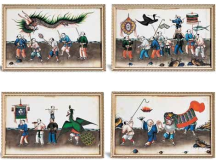
The tradition of appreciating lanterns on the Lantern Festival originates from the Eastern Han Dynasty, which has a bearing on the introduction of Buddhism into China at that time. It is a Buddhist convention that the monks would visit Buddhist relics and lighten up lanterns to show respect to Buddha on Jan. 15. Therefore, Emperors of that dynasty, who were determined to promote Buddhism, ordered people to lighten up lanterns in both palaces and temples on that night to show respect to Buddha. Additionally, civilians were all requested to hang up lanterns on that night, which is why the festival is called “Lantern Festival”. In the Song Dynasty, the custom of guessing riddles written on lanterns on Lantern Festival came into being and people at that time wrote riddles on paper strips and then pasted them on the colorful lanterns for others to appreciate and guess. In the Qing Dynasty, fireworks were set off to add fun, and the Lantern Festival by then witnessed a record-breaking grand occasion.
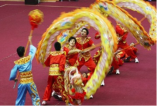
The traditional dim sum eaten on Lantern Festival is called “yuanxiao” (rice glue ball) or commonly called “tangyuan”. A meaning of family reunion and happiness may be felt even only from such name. Yuanxiao has its appearance made into a ball shape and white sugar, sweetened bean paste, sesame as the stuffing. Besides, walnut meat, nuts, and even meat can be used as the stuffing as well. Apart from the boiling manner, yuanxiao may also be prepared through deep frying and steaming manners.
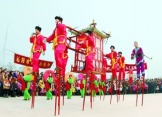
As time goes by, the Lantern Festival has enjoyed more and more celebrating activities. Some places even add traditional folk-custom performances such as playing dragon lantern, Lion Dancing, stilting, striking land boat, doing the Yangko, and striking Peace Drum. The Lantern Festival, a traditional Chinese festival which has experienced a history of over 2,000 years, is still very popular both at home and abroad, and any place where Chinese people live will witness a busy occasion on that day.
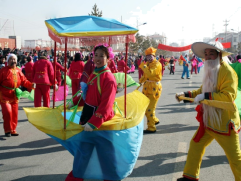
During the Lantern Festival, Valentine’s young men and women meet with the timing, the Lantern Festival and become China’s “Valentine’s Day.” (491 words)
1. According to the folk custom of China, what will people do on the night of the Lantern Festival?2. How did the custom of appreciating lanterns on the Lantern Festival come into being?
3. Do you know how to prepare yuanxiao? Tell your friends how to prepare it.
4. What kind of celebrating activities will be held in celebration the Lantern Festival?
5. Guess lantern riddles
(1). What has a mouth and a fork but never eats?
(2) What has a hand but can’t scratch itself?
(3). What has no skin or bones, yet has four fingers and a thumb?
(4). What part of a watch was used before by someone else?
(5). Why is an empty purse always the same?
(6). What is something that never asks any questions but demands a great many answers?
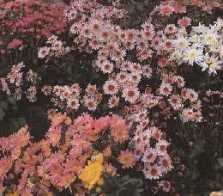
The Double Ninth Festival, also named Chong Yang Festival, falls on the ninth day of the ninth month of the Chinese lunar calendar, hence it gets name of Double Ninth Festival. On this day, people would like to drink chrysanthemum wine and have chrysanthemum cakes.
The chrysanthemum is a plant often used as a Chinese herbal medicine. People in ancient times believed that, in addition to detoxification, chrysanthemum could drive away evil spirits and prevent one from getting a cold in late autumn. So, making and drinking chrysanthemum could date back to many centuries, and it became the traditional food on the Double Ninth Festival, to avoid evil spirits and misfortunes. Besides, the Chinese word for wine is Jiu, a homonym of the Chinese word for long, symbolizing longevity.

Another special food for this festival is chrysanthemum cakes. The Chinese word for cake is Gao, a homonym of the Chinese word for high, symbolizing progress and promotion at work and in daily life and improvement in life year by year. In addition, mountains are high, so eating cakes can take the place of going for a climb -- by a stretch of the imagination.
Since nine is the highest odd digit, people take two of them together to signify longevity. Therefore, the ninth day of the ninth month has become a special day for people to pay their respects to the elderly and a day for the elderly to enjoy themselves. It has also been declared China’s Day for the Elderly.
 Origin
OriginThe festival is based on the theory of Yin and Yang, the two opposing principles in nature. Yin is feminine, negative principle, while Yang is masculine and positive. In ancient times people believed that all natural phenomena could be explained by this theory. Numbers were also related to this theory. Even numbers belonged to Yin and odd numbers to Yang. The ninth day of the ninth lunar month is a day when the two Yang numbers meet. So it is called Chong Yang. Chong means double in Chinese. Chong Yang has been an important festival since ancient times.
 Legend
Legend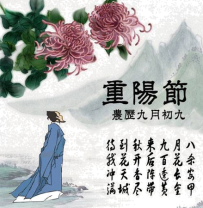
It is hard to say when these customs were created. But there are many stories which are closely related. As recorded in a historical book of the sixth century, in ancient times, there lived a man named Huan Jing. He was learning the magic arts from Fei Changfang, who had become an immortal after many years of practicing Taoism. One day, the two were climbing a mountain. Fei Changfang suddenly stopped and looked very upset. He told Huan Jing, On the ninth day of the ninth lunar month, disaster will come to your hometown. You must go home immediately. Remember to make a red bag for each one of your family members and put a spray of dogwood on every one. Then you must all tie your bags to your arms, leave home quickly and climb to the top of a mountain. Most importantly, you must all drink some chrysanthemum wine. Only by doing so can your family members avoid this disaster.
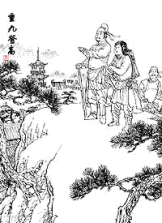
On hearing this, Huan Jing rushed home and asked his family to do exactly as his teacher said. The whole family climbed a nearby mountain and did not return until the evening. When they got back home, they found all their animals dead, including chickens, sheep, dogs and even the ox. Later Huan Jing told Fei Changfang about this. Fei said the poultry and livestock died in place of Huan Jing’s family, who escaped disaster by following his instructions.
Since then, climbing a mountain, carrying a spray of dogwood and drinking chrysanthemum wine became the traditional activities of the Double Ninth Festival, to avoid evil spirits and misfortunes.
 A Day for Outing
A Day for OutingThe festival is held in the golden season of autumn, at harvest-time. The bright clear weather and the joy of bringing in the harvest make for a festive happy atmosphere. The Double Ninth Festival is usually perfect for outdoor activities. Many people go hiking and climbing in the countryside, enjoying Mother Nature’s final burst of color before she puts on her dull winter cloak. Some will carry a spray of dogwood.
Therefore, it is now considered the last outing of the year before the beginning of winter, for people to go climbing to get some exercise as well as enjoy the autumn scenery.
1. Why is Chong Yang Festival called the Double Ninth Festival?2. Why would people like to drink chrysanthemum wine and have chrysanthemum cakes on the Double Ninth Festival?
3. Why is Chong Yang Festival also called China’s Day for the Elderly?
4. Tell your friends the legend of the Double Ninth Festival.



